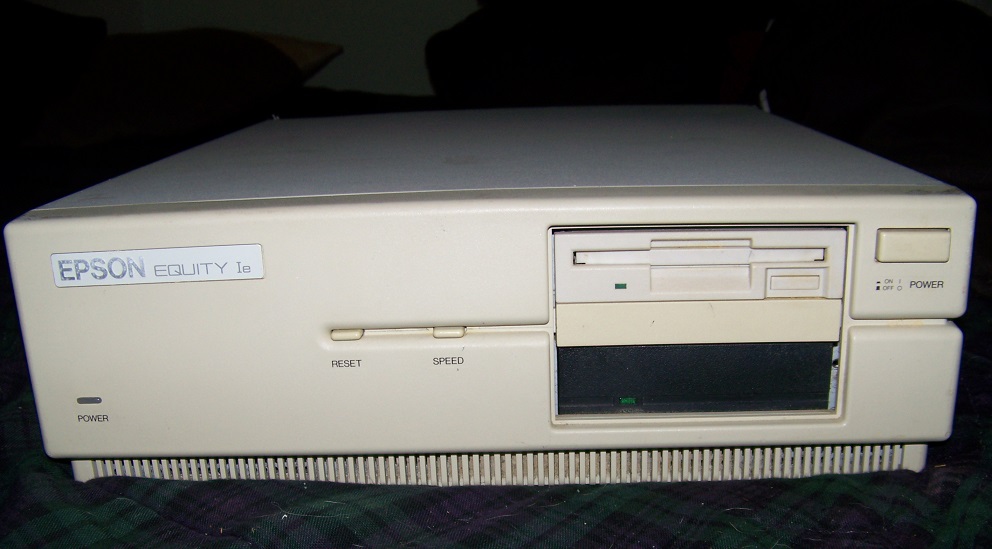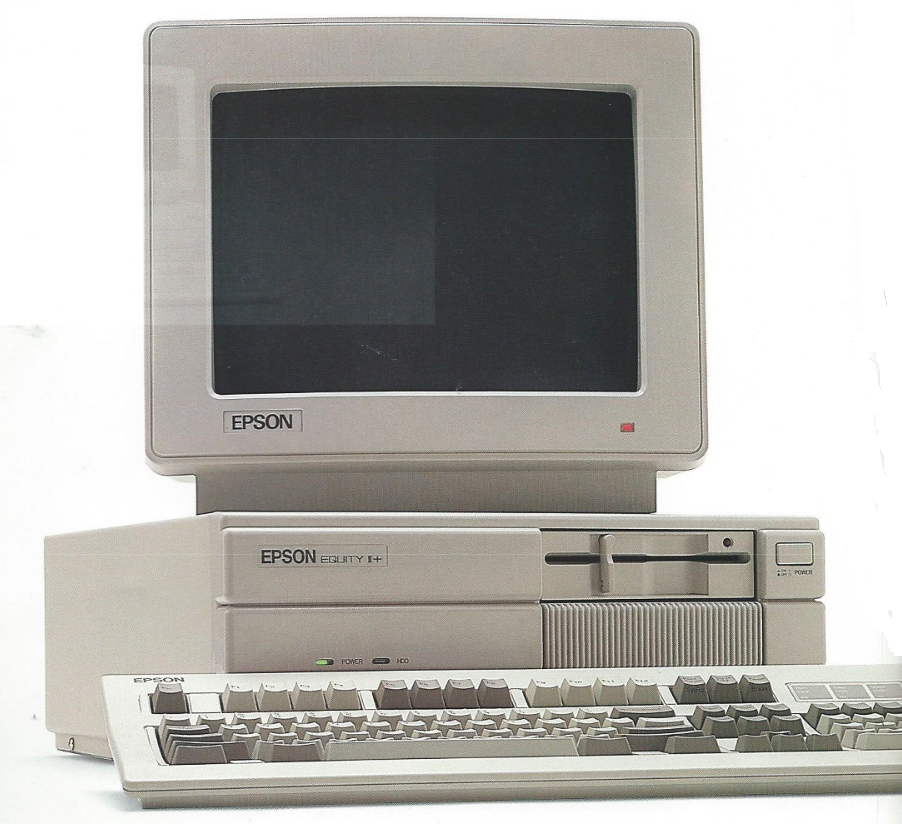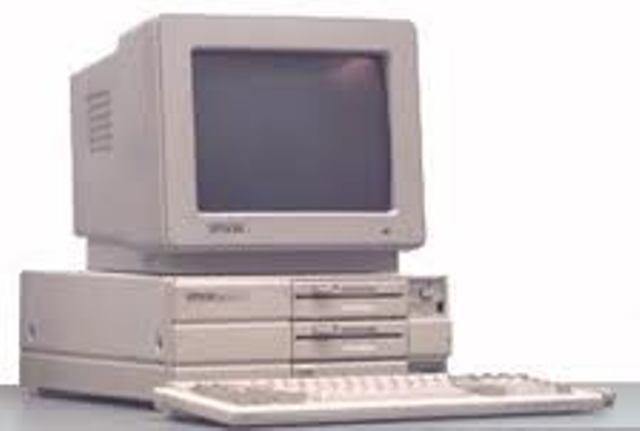Epson Equity
Introduction
Epson entered the PC-compatible market in 1985 with the Equity series. Already well-known for their dot-matrix printers, they went on to produce 11 PCs in the series, including some laptops. All Epson PCs were highly regarded as being very well-built and had good specifications for the price. Just as with IBM, these machines had evidence of being over-engineered (a good thing!).
Seiko-Epson, as the company was branded following thier merger, sold their computers in US, Europe, and also in the Far East. Initially, Equity III computers were manufactured in Nagano, Japan, but in mid-1987 they transferred production of their domestic-selling PCs to their Portland, OR site, in order to get around the punitive US import tariffs on Japanese micros. For Europe, Equity computers were manufactured in Telford, England. All Equity I, I+ and II+ models were manufactured in Korea.
Equity I
 The first computer in the Equity range was launched in 1985. Called Equity I, this had an Intel 8088 CPU running at 4.77 MHz, and by default came with 256 KB RAM.
The first computer in the Equity range was launched in 1985. Called Equity I, this had an Intel 8088 CPU running at 4.77 MHz, and by default came with 256 KB RAM.
It got a rather weedy 53-watt power supply, so upgrading these with a hard disk could present a problem without also upgrading the power supply.
Epson applied some thoughtful design touches to the Equity range, such as putting an extra set of rims along the right side of the main system case to allow it to be mounted vertically. Other nice touches included having the keyboard connector in the front of the case, not the rear, and having a flap on the front which conceal the DIP switches, power and reset buttons, and volume knob.
The Epson Equity I is a low-cost PC compatible with PC performance, 256K RAM, and three full-length expansion slots. If you want a second floppy disk drive, proprietary cables require that you buy the over-priced Epson unit." PC Magazine, March 31, 1987
The single floppy drive option was $795, with two floppy drives $995, or with a 20 MB hard disk $1,395. These prices were without a display card and monitor. A monochrome card and Epson-branded mono monitor was a cost option at $129 and $149 respectively.
It came with a special version of MS-DOS, called Epson DOS 2.11.
Equity I+
 The Equity I+ immediately followed the Equity I chronologically, with RAM expanded to 640 KB and the power supply got a boost from the Equity I's to 80W. In addition, the CPU could now be run at a "turbo" speed of 10 MHz (as opposed to the 7.16 MHz or 8 MHz speeds in similar "turbo" XTs).
The Equity I+ immediately followed the Equity I chronologically, with RAM expanded to 640 KB and the power supply got a boost from the Equity I's to 80W. In addition, the CPU could now be run at a "turbo" speed of 10 MHz (as opposed to the 7.16 MHz or 8 MHz speeds in similar "turbo" XTs).
The I+ came bundled with an Epson-branded MS-DOS 3.22, GW-BASIC, and some useful utility programs. Of the 5 expansion slots, 4 remain free after you purchased the graphics card of your choosing (which, like the monitor, was an extra cost-option). The total cost of a I+ with a medium-resolution colour monitor with two 5¼" 360 KB floppy drives was around $1,800. Upping the ante to an EGA video adapter/monitor combo and the cost rose to approximately $2,200.
For the more cost-conscious, an Epson monochrome monitor along with the company's "Multi-mode" graphics adapter which uniquely offered both a "medium resolution" CGA resolution and high resolution Hercules-compatible graphics, would run at $1,650 for the total system. This last option made the Equity I+ very cost-effective against the monochrome version of IBM's PS/2 Model 30 with which it directly competed, at $400 less.
The bottom "drive bay" on the front is actually a pull-down drawer, behind which is the reset button, turbo switch, and DIP switches to configure the system.
Equity Ie
 The Equity Ie is quite unique in the PC market, as it's possibly the only IBM PS/2 clone. Specifically, the Model 30 variant. What makes it unique is its adoption of IBM's MCGA video standard that was introduced with their PS/2 series of computers. The Ie had an Intel 8086 CPU running at 8 MHz, possibly one of the last off-the-shelf PCs to use this aging CPU. Several model variants existed for the Ie, including:
The Equity Ie is quite unique in the PC market, as it's possibly the only IBM PS/2 clone. Specifically, the Model 30 variant. What makes it unique is its adoption of IBM's MCGA video standard that was introduced with their PS/2 series of computers. The Ie had an Intel 8086 CPU running at 8 MHz, possibly one of the last off-the-shelf PCs to use this aging CPU. Several model variants existed for the Ie, including:
- 2 x 3½" 720K floppy drive
- 1 x 3½" 720K floppy drive + 20 MB MFM hard disk drive.
It supported only 3½" external drive bays, so you couldn't fit a 5¼" floppy drive into this unit. Pressing the 'Speed' button on the front of the case boosted the 8086 CPU to run at 10 MHz, which also made the Power LED change from amber to green. On the rear it further cloned the PS/2 Model in its 'early' adoption of the PS/2 mouse and keyboard sockets (which is how these sockets got their name). The motherboard on the Epson Equity Ie is a refinement on older XT-style boards. Some XT motherboards featuring the Intel 8086 still had an 8-bit logic board but the motherboard in the Ie has a fully 16-bit data bus with zero wait states taking full advantage of the power of the Intel 8086. Expansion-wise, the motherboard has a riser slot, whose riser card supports up to four 8-bit ISA cards. The keyboard plugged into the front of the system unit
Equity II
Epson's third PC was the Equity II. It made use of the NEC V30 microprocessor, which can operate at two speeds (4.77 MHz and 7.16 MHz). Essentially, it's an IBM PC/XT-compatible computer with a more powerful processor, one 5¼" 360K floppy drive, a slow hard disk drive, and five 8-bit expansion slots. It came bundled with an Epson-flavoured MS-DOS 3.10 that included on-line help that displays information about each DOS command, GW-BASIC, a variety of Epson utility programs, and Xtree file manager.
Equity II+
 The II+ was an 80286 PC with 640 KB RAM. The clock speed was selectable from 8 MHz to 12 MHz. The memory could be expanded up to 15.5 MB using memory expansion cards. It came with a built-in realtime clock with calendar, backed up by a CMOS battery.
The II+ was an 80286 PC with 640 KB RAM. The clock speed was selectable from 8 MHz to 12 MHz. The memory could be expanded up to 15.5 MB using memory expansion cards. It came with a built-in realtime clock with calendar, backed up by a CMOS battery.
It had built-in parallel and serial ports for convenient interfacing with modems, printers, mice and other peripheral devices. For expansion, there were 6 full-length ISA expansion slots - three 8-bit PC/XT slots, and three 16-bit AT slots.
It was available in two configurations:
- 1.2 MB 5.25" floppy drive
- 1.2 MB 5.25" floppy drive and 40 MB hard disk with 28ms access time.
Equity III and III+
The Equity III was an Intel 80286 PC launched in mid-1987, and was available in two sub-models. The first came with a single 5.25" 1.2 MB high-density floppy drive. The second had the same floppy drive plus a 40 MB hard disk. Both models came with 640 KB of RAM as standard.
Expansion was possible, as there was room for a second 5.25"-sized floppy drive and a second hard disk. It shipped with MS-DOS 3.2.
Unlike the earlier Equity models, the III+ hid away most of its lesser-used buttons behind a panel on the front-left of the system unit. Pulling this panel down revealed a volume control knob to decrease or increase the PC speaker, the speed select switch, and the monitor select switch (to tell the computer if you were using a mono or colour monitor).
The III+ came with 9 ISA expansion slots for fitting what Epson refer to as "Option Cards". Three of these are 8-bit, and the remaining six are 16-bit. Two of these were populated from the factory, as they contained the 8-bit parallel/serial and floppy disk controller card, and the 16-bit hard disk controller card.
Equity LT
 Their first laptop computer, released in 1989, ran an NEC V30 (about 10-30% faster than the Intel 8086 and was 100% compatible), 640 KB RAM, 21 MB RLL hard disk, two "option" slots (8-bit ISA), and monochrome CGA graphics with RGB output for an external monitor.
Their first laptop computer, released in 1989, ran an NEC V30 (about 10-30% faster than the Intel 8086 and was 100% compatible), 640 KB RAM, 21 MB RLL hard disk, two "option" slots (8-bit ISA), and monochrome CGA graphics with RGB output for an external monitor.
Equity LT286
Epson's 286 laptop sold for £699 in the UK. It was fully XT/AT compatible, running an Intel 80286 at a switchable 8 MHz or 12 MHz. The standard 640 KB RAM could be expanded to 4.6 MB in 2 MB increments, and as standard came with a 3½" 1.44 MB floppy drive and a 20 MB hard disk drive. In Europe, the LT286 was known as the Epson PC AX Portable.
The screen was a backlit NTN monochrome. The laptop came bundled with MS-DOS 3.3, GW-BASIC and a set of manuals.
Optional extras included a black nylon carry case for £25, and extra AC adapter (£15), the 'Expansion Chassis' which attached to the base of the portable and provided two extra slots (16-bit ISA and 8-bit ISA), and you could plug in VGA and network plugs. This was £45.
A final optional extra was the 2 MB memory upgrades which cost £199 each.
Equity 286
Equity 386SX
 The Equity 386SX/20 Plus arrived at the start of 1992, having been announced in April 1991. It came with 2 MB of fast zero wait-state 80ns DRAM, which is expandable to 14 MB using SIMMs. Two hard disk drive options are available: 40 MB or 100 MB. The computer also get a 32 KB 32ns SRAM cache to speed up often-used instructions. Epson offered three VGA monitors with the 386SX/20 Plus - monochrome, regular and extended, as well as three operating system choices: MS-DOS 3.3, 4.01, or 5.0. You did have to pay extra for these though, despite the fact that they bundled Microsoft Windows 3.0 for free with every purchase of this computer!
The Equity 386SX/20 Plus arrived at the start of 1992, having been announced in April 1991. It came with 2 MB of fast zero wait-state 80ns DRAM, which is expandable to 14 MB using SIMMs. Two hard disk drive options are available: 40 MB or 100 MB. The computer also get a 32 KB 32ns SRAM cache to speed up often-used instructions. Epson offered three VGA monitors with the 386SX/20 Plus - monochrome, regular and extended, as well as three operating system choices: MS-DOS 3.3, 4.01, or 5.0. You did have to pay extra for these though, despite the fact that they bundled Microsoft Windows 3.0 for free with every purchase of this computer!
The computer came with four full-sized expansion slots - three 16-bit and one 8-bit. The standard ports (parallel, serial, mouse, keyboard and video adapter) are all integrated into the system board.
The built-in VGA adapter came with 512 KB of video memory, and supported up to 800 x 600 in 16 colours, or up to 640 x 480 in 256 colours.
At the time of announcement, prices for the 386SX/20 were:
Single 3.5" floppy drive variant - $2,300
100 MB hard disk variant - $3,450
- Equity 386DX
Compatibility
Hardware - BIOS
The Equity I+ broke from the norm of the IBM PC and PC/XT computers by incorporating a battery-backed clock. It ran a lithium barrel battery rather than the more common Ni-Cad type. Not only was this irregular for the time, but they even kept the battery far away from everything else on the motherboard, so if the battery leaked it wouldn't harm the rest of the board.
Hardware - MEMORY
The Equity Ie came with 640 KB of SDRAM chips soldered onto the motherboard. Expanding the unit to the maximum 1 MB would require an 8-bit ISA memory expansion card, although given that it's an XT computer almost no software would really require additional RAM.
Hardware - POWER SUPPLY
.
Hardware - FLOPPY DRIVES
Both the Equity I and Ie have an embedded floppy disk controller on the motherboard. This cannot be disabled which means you are limited to 720 KB floppy drives only.
Hardware - HARD DRIVES
.
HARDWARE - VIDEO
The Equity I+ came with an unusual "multi-mode" graphics adapter. This could run in either CGA mode, or high-resolution Hercules monochrome mode. This gave cost-conscious buyers the best of two worlds at a competitive price point.
Among other things, embedded on the Ie motherboard is the MCGA video electronics. Remember this is the only non-IBM PC to use MCGA ! On the back of the system unit is the standard 15-pin D-SUB connector for a monitor. This is the same connector as VGA uses, since MCGA is a kind of cost-reduced version of VGA which supports the same colour palette but at lower resolution. MCGA is fully backward-compatible with CGA, but strangely not with EGA.
You can fit an EGA or VGA card into an expansion slot to upgrade the video capabilities.
Strangely, the user guide for the Equity III+ stipulates that the video card must be installed in slot 7 (of 9) - this is the one third-closest to the power supply. I can only imagine this is due to the order in which the BIOS allocates IRQs to the cards.
Just as with IBM PCs, the Equity III+ power supply includes a power output socket for the monitor.
Hardware - MOUSE and keyboard
Also copying the IBM PS/2 Model 30, the Equity Ie sports two PS/2 connectors on the rear - one for the keyboard, and the second for a mouse.
The keyboard itself, just like the PS/2 line has a completely detachable cable. The cable has a similar connector to a modern-day RJ45 network plug, which connects into the back of the keyboard.
Hardware - expansion
The Equity I+ came with 5 ISA expansion slots, although one was always occupied with the video card of your choosing, depending on the sub-model you bought.
The Equity Ie employs a riser card which fits into the only slot on the motherboard. The riser card provides 4 8-bit ISA expansion slots fitted sideways, one on top of the other.
HARDWARE - CPU
On the front of the Equity I+ and Ie is the "Speed" button. When pressed it speeds up the CPU from its stock 8 MHz to 10 MHz. This differs from almost every other PC clone which calls its button "Turbo", but actually massively slows down the computer from its stock full speed to well below half in most cases. When the "Speed" button is pressed the power LED also switches from orange to green.
The "Speed" selector was enhanced further on the Equity III and III+, as it provided 3 options via a slider. You could choose to run the 80286 CPU at 6 MHz, 8 MHz or 12 MHz, from left to right.
Epson made use of the many licensed CPU manufacturers on their machines. It wasn't uncommon to have an AMD-branded 8086 inside your I+ or Ie, rather than a "true" Intel chip.
Software
.
Physical
Equity I:
System Unit: 14.4 (W) x 14.2 (D) x 5.7 (H) in.
Weight: 19.8 lbs.
Equity III:
System Unit: 499 (W) x 442 (D) x 169 (H) mm
Weight: 14.95 kg (31.97 lbs) - single floppy only, or 16.2 kg (35.71 lbs) - single floppy and 40 MB hard disk